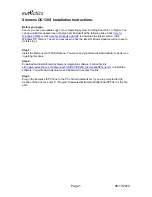
Preparing vCenter Server Databases
vCenter Server and vSphere Update Manager require databases to store and organize server data.
Each vCenter Server instance must have its own database. For small installations (up to 5 hosts and 50
virtual machines), you can use the bundled Microsoft SQL Server 2008 Express database, which you can
choose to have the vCenter Server installer create during the vCenter Server installation. Larger installations
require a supported database, prepared as described in the subtopics of this section.
vCenter Server instances cannot share the same database schema. Multiple vCenter Server databases can
reside on the same database server, or they can be separated across multiple database servers. For Oracle
databases, which have the concept of schema objects, you can run multiple vCenter Server instances in a
single database server if you have a different schema owner for each vCenter Server instance. You can also
use a dedicated Oracle database server for each vCenter Server instance.
You do not need to install a new database server for the vCenter Server installation to work. During
vCenter Server installation, you can point the vCenter Server system to any existing supported database.
vCenter Server supports Oracle and Microsoft SQL Server databases. Update Manager supports Oracle and
Microsoft SQL Server databases. For information about supported database server versions, see the VMware
Product Interoperability Matrix at
http://www.vmware.com/resources/compatibility/sim/interop_matrix.php
.
C
AUTION
If you have a VirtualCenter database that you want to preserve, do not perform a fresh installation
of vCenter Server. See the vSphere Upgrade documentation.
VMware recommends using separate databases for vCenter Server and Update Manager. For a small
deployments, a separate database for Update Manager might not be necessary.
vCenter Server Database Configuration Notes
After you choose a supported database type, make sure you understand any special configuration
requirements.
Table 3-1
is not a complete list of databases supported with vCenter Server. For information about specific
database versions and service pack configurations supported with vCenter Server, see the
VMware Product
Interoperability Matrixes
. This topic is intended only to provide special database configuration notes not
listed in the Product Interoperability Matrixes.
vCenter Server databases require a UTF code set.
Contact your DBA for the appropriate database credentials.
Table 3
‑
1.
Configuration Notes for Databases Supported with vCenter Server
Database Type
Configuration Notes
Microsoft SQL Server 2008
R2 Express
Bundled database that you can use for small deployments of up to 5 hosts and 50 virtual
machines.
N
OTE
This database is not supported for the vCenter Server Appliance.
Microsoft SQL Server 2005
Ensure that the machine has a valid ODBC DSN entry.
If Microsoft SQL Server 2005 is not already installed and the machine has MSXML Core
Services 6.0 installed, remove MSXML Core Services 6.0 before installing Microsoft SQL
Server 2005. If you cannot remove it using the Add or Remove Programs utility, use the
Windows Installer CleanUp utility. See
http://support.microsoft.com/kb/968749
.
N
OTE
This database is not supported for the vCenter Server Appliance.
vSphere Installation and Setup
30
VMware, Inc.
Содержание VS4-ENT-PL-A - vSphere Enterprise Plus
Страница 6: ...vSphere Installation and Setup 6 VMware Inc ...
Страница 8: ...vSphere Installation and Setup 8 VMware Inc ...
Страница 10: ...vSphere Installation and Setup 10 VMware Inc ...
Страница 28: ...vSphere Installation and Setup 28 VMware Inc ...
Страница 70: ...vSphere Installation and Setup 70 VMware Inc ...
Страница 100: ...vSphere Installation and Setup 100 VMware Inc ...
Страница 122: ...vSphere Installation and Setup 122 VMware Inc ...
Страница 138: ...vSphere Installation and Setup 138 VMware Inc ...
















































